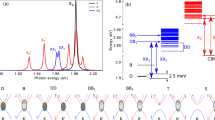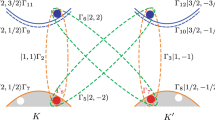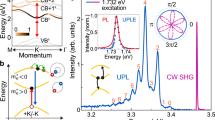Abstract
The optical properties of atomically thin transition metal dichalcogenide (TMDC) semiconductors are shaped by the emergence of correlated many-body complexes due to strong Coulomb interaction. Exceptional electron–hole exchange predestines TMDCs to be used to study fundamental and applied properties of Coulomb complexes such as valley depolarization of excitons and fine-structure splitting of trions. Biexcitons in these materials are less well understood and it has been established only recently that they are spectrally located between excitons and trions. Here we show that biexcitons in monolayer TMDCs exhibit a distinct and rich fine structure on the order of millielectronvolts due to electron–hole exchange. Ultrafast pump–probe experiments on monolayer WSe2 reveal decisive biexciton signatures and a fine structure in excellent agreement with a microscopic theory. We provide a pathway to understand the complex spectral structure of higher-order Coulomb complexes in TMDCs going beyond the usual classification scheme in terms of four-particle configurations.
This is a preview of subscription content, access via your institution
Access options
Access Nature and 54 other Nature Portfolio journals
Get Nature+, our best-value online-access subscription
$29.99 / 30 days
cancel any time
Subscribe to this journal
Receive 12 print issues and online access
$209.00 per year
only $17.42 per issue
Buy this article
- Purchase on Springer Link
- Instant access to full article PDF
Prices may be subject to local taxes which are calculated during checkout



Similar content being viewed by others
Data availability
The data that support the plots within this paper and other findings of this study are available from the corresponding author upon reasonable request.
References
Onodera, Y. & Toyozawa, Y. Excitons in alkali halides. J. Phys. Soc. Jpn 22, 833–844 (1967).
Denisov, M. M. & Makarov, V. P. Longitudinal and transverse excitons in semiconductors. Phys. Status Solidi B 56, 9–59 (1973).
Warming, T. et al. Hole–hole and electron–hole exchange interactions in single InAs/GaAs quantum dots. Phys. Rev. B 79, 125316 (2009).
Kadantsev, E. & Hawrylak, P. Theory of exciton fine structure in semiconductor quantum dots: Quantum dot anisotropy and lateral electric field. Phys. Rev. B 81, 045311 (2010).
Sieh, C. et al. Coulomb memory signatures in the excitonic optical Stark effect. Phys. Rev. Lett. 82, 3112–3115 (1999).
Schäfer, W. & Wegener, M. Semiconductor Optics and Transport Phenomena (Springer, Berlin, New York, 2002).
Forney, J. J., Quattropani, A. & Bassani, F. Electron–hole exchange contributions to the biexciton states. Il Nuovo Cimento B 22, 153–178 (1974).
Quattropani, A., Forney, J. J. & Bassani, F. Biexcitons in indirect-gap semiconductors: applications to GaSe and AgBr. Phys. Status Solidi B 70, 497–504 (1975).
Ekardt, W. & Sheboul, M. I. The influence of the electron–hole exchange interaction on the biexciton ground state in CuCl and CuBr and related optical transitions. Physica Status Solidi B 73, 475–482 (1976).
Bassani, F. & Rovere, M. Biexciton binding energy in Cu2O. Solid State Commun. 19, 887–890 (1976).
Quattropani, A. & Forney, J. J. Theory of excitonic molecules. Il Nuovo Cimento B 39, 569–578 (1977).
Chung, S. G., Sanders, G. D. & Chang, Y.-C. Theory of excitonic molecules in thallous halide: The role of electron-hole exchange interaction. Solid State Commun. 45, 237–241 (1983).
Ungier, W. Electron–hole exchange interaction in a biexciton molecule. Solid State Commun. 69, 53–55 (1989).
Yu, T. & Wu, M. W. Valley depolarization due to intervalley and intravalley electron-hole exchange interactions in monolayer MoS2. Phys. Rev. B 89, 205303 (2014).
Yu, H., Liu, G.-B., Gong, P., Xu, X. & Yao, W. Dirac cones and Dirac saddle points of bright excitons in monolayer transition metal dichalcogenides. Nat. Commun. 5, 3876 (2014).
Glazov, M. M. et al. Spin and valley dynamics of excitons in transition metal dichalcogenide monolayers. Phys. Status Solidi B 252, 2349–2362 (2015).
Schmidt, R. et al. Ultrafast Coulomb-induced intervalley coupling in atomically thin WS2. Nano Lett. 16, 2945–2950 (2016).
Hao, K. et al. Direct measurement of exciton valley coherence in monolayer WSe2. Nat. Phys. 12, 677–682 (2016).
Qiu, D. Y., Cao, T. & Louie, S. G. Nonanalyticity, valley quantum phases, and lightlike exciton dispersion in monolayer transition metal dichalcogenides: theory and first-principles calculations. Phys. Rev. Lett. 115, 176801 (2015).
Jones, A. M. et al. Excitonic luminescence upconversion in a two-dimensional semiconductor. Nat. Phys. 12, 323–327 (2016).
Plechinger, G. et al. Trion fine structure and coupled spin–valley dynamics in monolayer tungsten disulfide. Nat. Commun. 7, 12715–12723 (2016).
Singh, A. et al. Long-lived valley polarization of intravalley trions in monolayer WSe2. Phys. Rev. Lett. 117, 257402 (2016).
Voss, T., Rückmann, I., Gutowski, J., Axt, V. M. & Kuhn, T. Coherent control of the exciton and exciton–biexciton transitions in the generation of nonlinear wave-mixing signals in a semiconductor quantum well. Phys. Rev. B 73, 115311 (2006).
Gilliot, P. et al. Measurement of exciton spin coherence by nondegenerate four-wave mixing experiments in the χ (3) regime. Phys. Rev. B 75, 125209 (2007).
Mayers, M. Z., Berkelbach, T. C., Hybertsen, M. S. & Reichman, D. R. Binding energies and spatial structures of small carrier complexes in monolayer transition-metal dichalcogenides via diffusion Monte Carlo. Phys. Rev. B 92, 161404 (2015).
Zhang, D. K., Kidd, D. W. & Varga, K. Excited biexcitons in transition metal dichalcogenides. Nano Lett. 15, 7002–7005 (2015).
Kylänpää, I. & Komsa, H.-P. Binding energies of exciton complexes in transition metal dichalcogenide monolayers and effect of dielectric environment. Phys. Rev. B 92, 205418 (2015).
Szyniszewski, M., Mostaani, E., Drummond, N. D. & Fal’ko, V. I. Binding energies of trions and biexcitons in two-dimensional semiconductors from diffusion quantum Monte Carlo calculations. Phys. Rev. B 95, 081301 (2017).
Hao, K. et al. Neutral and charged inter-valley biexcitons in monolayer MoSe2. Nat. Commun. 8, 15552 (2017).
Mai, C. et al. Many-body effects in valleytronics: direct measurement of valley lifetimes in single-layer MoS2. Nano Lett. 14, 202–206 (2014).
You, Y. et al. Observation of biexcitons in monolayer WSe2. Nature Physics 11, 477–481 (2015).
Plechinger, G. et al. Identification of excitons, trions and biexcitons in single-layer WS2. Phys. Status Solidi Rapid Res. Lett. 9, 457–461 (2015).
Shang, J. et al. Observation of excitonic fine structure in a 2D transition-metal dichalcogenide semiconductor. ACS Nano 9, 647–655 (2015).
Sie, E. J., Frenzel, A. J., Lee, Y.-H., Kong, J. & Gedik, N. Intervalley biexcitons and many-body effects in monolayer MoS2. Phys. Rev. B 92, 125417 (2015).
Lee, H. S., Kim, M. S., Kim, H. & Lee, Y. H. Identifying multiexcitons in MoS2 monolayers at room temperature. Phys. Rev. B 93, 140409 (2016).
Okada, M. et al. Observation of biexcitonic emission at extremely low power density in tungsten disulfide atomic layers grown on hexagonal boron nitride. Sci. Rep. 7, 322 (2017).
Van Tuan, D., Scharf, B., Žutić, I. & Dery, H. Marrying excitons and plasmons in monolayer transition-metal dichalcogenides. Phys. Rev. X 7, 041040 (2017).
Xu, X., Yao, W., Xiao, D. & Heinz, T. F. Spin and pseudospins in layered transition metal dichalcogenides. Nat. Phys. 10, 343–350 (2014).
Hulin, D. & Joffre, M. Excitonic optical stark redshift: the biexciton signature. Phys. Rev. Lett. 65, 3425–3428 (1990).
Tran, K. et al. Disorder-dependent valley properties in monolayer WSe2. Phys. Rev. B 96, 041302 (2017).
Kern, J. et al. Nanoscale positioning of single-photon emitters in atomically thin WSe2. Adv. Mater. 28, 7101–7105 (2016).
Branny, A., Kumar, S., Proux, R. & Gerardot, B. D. Deterministic strain-induced arrays of quantum emitters in a two-dimensional semiconductor. Nat. Commun. 8, 15053 (2017).
Palacios-Berraquero, C. et al. Large-scale quantum-emitter arrays in atomically thin semiconductors. Nat. Commun. 8, 15093 (2017).
He, Y.-M. et al. Cascaded emission of single photons from the biexciton in monolayered WSe2. Nat. Commun. 7, 13409 (2016).
Axt, V. M. & Stahl, A. A dynamics-controlled truncation scheme for the hierarchy of density matrices in semiconductor optics. Z. Phys. B 93, 195–204 (1994).
Lindberg, M., Hu, Y. Z., Binder, R. & Koch, S. W. Χ (3) formalism in optically excited semiconductors and its applications in four-wave-mixing spectroscopy. Phys. Rev. B 50, 18060 (1994).
Sham, L. J. & Rice, T. M. Many-particle derivation of the effective-mass equation for the Wannier exciton. Phys. Rev. 144, 708–714 (1966).
Hernandez, V., Roman, J. E. & Vidal, V. SLEPc: a scalable and flexible toolkit for the solution of eigenvalue problems. ACM Trans. Math. Softw. 31, 351–362 (2005).
Balay, S. et al. Portable, extensible toolkit for scientific computation. Argonne National Laboratory http://www.mcs.anl.gov/petsc/ (2018).
Steinhoff, A., Rösner, M., Jahnke, F., Wehling, T. O. & Gies, C. Influence of excited carriers on the optical and electronic properties of MoS2. Nano Lett. 14, 3743–3748 (2014).
Liu, G.-B., Shan, W.-Y., Yao, Y., Yao, W. & Xiao, D. Three-band tight-binding model for monolayers of group-VIB transition metal dichalcogenides. Phys. Rev. B 88, 085433 (2013).
FLEUR: The Jülich FLAPW code family. FLEUR http://www.flapw.de/pm/index.php (2018).
Friedrich, C., Blügel, S. & Schindlmayr, A. Efficient implementation of the GW approximation within the all-electron FLAPW method. Phys. Rev. B 81, 125102 (2010).
Rösner, M., Şaşıoğlu, E., Friedrich, C., Blügel, S. & Wehling, T. O. Wannier function approach to realistic Coulomb interactions in layered materials and heterostructures. Phys. Rev. B 92, 085102 (2015).
Florian, M. et al. The dielectric impact of layer distances on exciton and trion binding energies in van der Waals heterostructures. Nano Lett. 18, 2725–2732 (2018).
Steinhoff, A. et al. Exciton fission in monolayer transition metal dichalcogenide semiconductors. Nat. Commun. 8, 1166 (2017).
Rooney, A. P. et al. Observing imperfection in atomic interfaces for van der Waals heterostructures. Nano Lett. 17, 5222–5228 (2017).
Xiao, D., Yao, W. & Niu, Q. Valley-contrasting physics in graphene: magnetic moment and topological transport. Phys. Rev. Lett. 99, 236809 (2007).
Singh, A. et al. Trion formation dynamics in monolayer transition metal dichalcogenides. Phys. Rev. B 93, 041401 (2016).
Combescot, M. & Combescot, R. Excitonic Stark shift: a coupling to semivirtual biexcitons. Phys. Rev. Lett. 61, 117–120 (1988).
Wang, G. et al. In-plane propagation of light in transition metal dichalcogenide monolayers: optical selection rules. Phys. Rev. Lett. 119, 047401 (2017).
Zhang, X.-X. et al. Magnetic brightening and control of dark excitons in monolayer WSe2. Nat. Nanotech. 12, 883–888 (2017).
Danovich, M., Zólyomi, V. & Fal’ko, V. I. Dark trions and biexcitons in WS2 and WSe2 made bright by e–e scattering. Sci. Rep. 7, 45998 (2017).
Acknowledgements
This work was supported by Deutsche Forschungsgemeinschaft (DFG) within CRC 1558 and RTG 2247. A.W.A. acknowledges funding from DFG via grant no. AC290-2/1. The spectroscopic experiments were jointly supported by NSF DMR1306878 (A. Singh) and the NSF MRSEC program DMR-1720595 (K.T.). X.L. gratefully acknowledges support from the Welch foundation (F-1662) and the Alexander von Humboldt Foundation, which facilitated the collaboration with TU-Berlin. A. Steinhoff and M.F. would like to acknowledge P. Gartner for fruitful discussions. We thank G. Schönhoff, M. Rösner and T. Wehling for providing material-realistic band structures and bare as well as screened Coulomb matrix elements.
Author information
Authors and Affiliations
Contributions
A. Steinhoff and M.F. performed analytical and numerical calculations of the biexciton spectra. A. Singh, K.T. and M.K. designed and performed the experiments. K.T. exfoliated the sample. N.O., A. Singh, A.W.A. and S.H. analysed the data. N.O., A. Steinhoff, M.F. and A. Singh prepared the manuscript. U.W., F.J. and X.L. initiated and coordinated the project. All authors contributed to the discussion and the writing of the manuscript.
Corresponding author
Ethics declarations
Competing interests
The authors declare no competing interests.
Additional information
Publisher’s note: Springer Nature remains neutral with regard to jurisdictional claims in published maps and institutional affiliations.
Supplementary information
Supplementary Information
7 chapters, 6 figures, 1 table, 23 references
Rights and permissions
About this article
Cite this article
Steinhoff, A., Florian, M., Singh, A. et al. Biexciton fine structure in monolayer transition metal dichalcogenides. Nature Phys 14, 1199–1204 (2018). https://doi.org/10.1038/s41567-018-0282-x
Received:
Accepted:
Published:
Issue Date:
DOI: https://doi.org/10.1038/s41567-018-0282-x
This article is cited by
-
Versatile optical manipulation of trions, dark excitons and biexcitons through contrasting exciton-photon coupling
Light: Science & Applications (2023)
-
Symmetry-dependent exciton-exciton interaction and intervalley biexciton in monolayer transition metal dichalcogenides
npj 2D Materials and Applications (2022)
-
Upconversion photoluminescence excitation reveals exciton–trion and exciton–biexciton coupling in hBN/WS\(_{2}\)/hBN van der Waals heterostructures
Scientific Reports (2022)
-
Biexcitons fine structure and non-equilibrium effects in transition metal dichalcogenides monolayers from first principles
Communications Physics (2021)
-
Approaching the intrinsic exciton physics limit in two-dimensional semiconductor diodes
Nature (2021)



